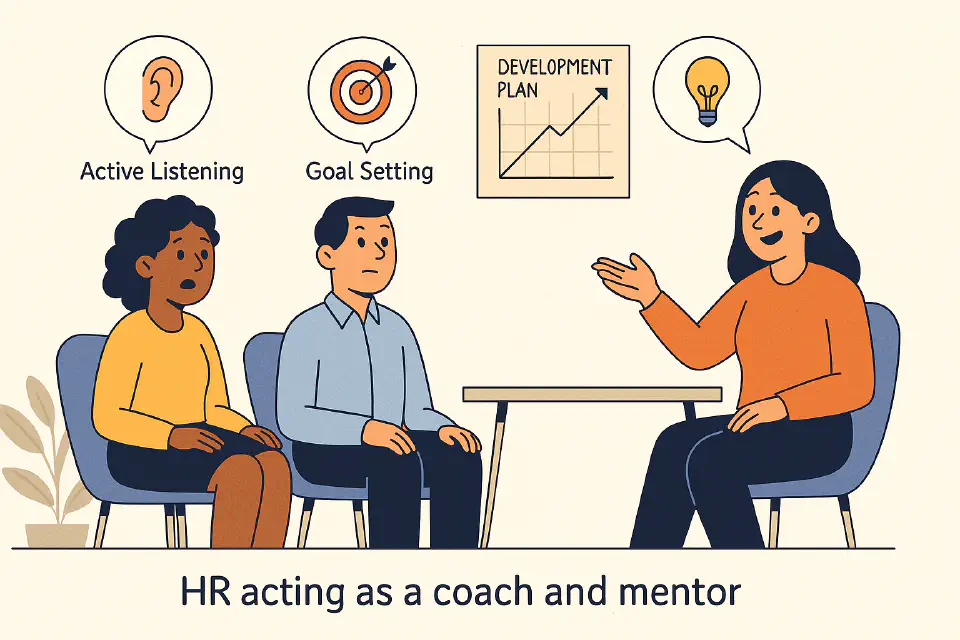
HR as a Coach and Enabler
Today’s HR doesn’t just write policies — it enables people to perform, grow, and lead. This page explores the essential role of HR as a coach and enabler of human potential, leadership capability, and team performance.
Why HR Must Coach and Enable
In many organizations, HR is still seen as either a watchdog (compliance) or a service center (transactional support). But modern HR plays a much more impactful role:
- Helping people navigate complexity
- Developing leadership across the business
- Creating the conditions for trust, feedback, and growth
This shift is not about “doing more HR” — it’s about helping others do their jobs better.
When HR enables people well, the business scales, adapts, and retains talent. When it doesn’t, managers become overloaded, under-skilled, and disengaged.
Coaching vs. Enabling: What’s the Difference?
Though closely related, these are distinct roles:
- Coaching = guiding individuals through reflection and action
- Enabling = building structures, tools, and environments that support success
Coaching focuses on people. Enabling focuses on systems.
Great HR teams do both.
Theoretical Foundations
1. Coaching Models in HR
HR professionals often draw from models like:
- GROW (Goal, Reality, Options, Will)
- CLEAR (Contract, Listen, Explore, Action, Review)
- Solution-Focused Coaching
These models support HR in guiding conversations with:
- People leaders
- Executives
- Underperforming employees
2. Enablement Through Systems Thinking
Enabling is about designing environments where good behavior becomes easy. This includes:
- Clear processes and expectations
- Aligned incentives and tools
- Removing blockers to performance
This aligns with theories like:
- Self-determination theory (autonomy, mastery, purpose)
- Psychological safety (Amy Edmondson)
- Job demands-resources model
HR’s Coaching Responsibilities
🔹 Leadership Development
- Providing executive and mid-level coaching
- Supporting high-potential talent
- Running internal coaching programs
🔹 Performance Conversations
- Helping managers deliver feedback
- Building skills around goal-setting, listening, and development planning
🔹 Transition Coaching
- Supporting newly promoted leaders
- Guiding employees through organizational change or exits

HR’s Enabling Responsibilities
🔹 Manager Enablement
- Creating toolkits, templates, and learning journeys
- Supporting onboarding for people managers
- Hosting manager forums and peer learning sessions
🔹 Team Enablement
- Facilitating team health checks and retrospectives
- Providing conflict resolution support
- Supporting cross-functional collaboration
🔹 Systemic Support
- Designing performance frameworks that enable growth
- Embedding check-in rhythms and rituals (e.g. 1:1s, quarterly reviews)
- Creating self-service resources in the HRIS or knowledge base
Real-World Examples
Case 1: Coaching First-Time Managers
HR noticed new team leads struggled with delegation and feedback. They launched:
- A 6-week peer coaching group
- Biweekly reflection prompts
- Scenario-based coaching workshops
Outcome: 78% of participants reported improved confidence; team feedback scores improved.
Case 2: Manager Enablement for Remote Leadership
Post-COVID, HR developed:
- Virtual manager onboarding
- Guides on leading remote 1:1s and recognizing distributed teams
- A Q&A bank for common challenges
Outcome: Managers adopted tools at scale. Attrition on remote teams declined.
Case 3: Enabling High-Performing Teams
In a product division, HR facilitated:
- Quarterly health check-ins
- Team chartering sessions
- Decision-making alignment tools
Result: Teams reported more clarity, faster collaboration, and higher trust.
What HR Needs to Succeed as a Coach & Enabler
| Capability | Application |
|---|---|
| Coaching Mindset | Ask over tell; guide over instruct |
| Business Context | Understand team goals, pressures, and strategy |
| Listening & Empathy | Create space for trust, fear, and uncertainty |
| Process Design | Build scalable frameworks, not one-off fixes |
| Facilitation | Support conversations that create clarity and alignment |
What Gets in the Way
Common blockers:
- HR seen as problem-solver, not enabler
- Managers not open to feedback or coaching
- Time pressure to “just fix it”
- Lack of alignment between HR and business needs
Best Practice: Build Coaching Into the System
Final Thought
Enabling others is one of HR’s most powerful — and underused — roles.
By shifting from reactive support to proactive enablement, HR builds stronger leaders, better teams, and a more resilient organization.
Because in the end, great HR doesn’t do it all — it makes others better at what they do.